Written by Veronica |
China is the hometown of tea and the birthplace of tea culture. Chinese tea culture has a long and rich history which can be dated back to around 5,000 years ago. It has had a great influence on the development of Chinese culture, philosophy, art, social customs, and so on, and continues to be an essential part of people’s daily life in China.
Chinese tea is also celebrated for its great diversity, and there are various kinds of tea, such as dark tea, oolong tea and green tea, served at any fine Chinese restaurant and teahouse. Visitors can have a try of the refreshing Chinese tea while enjoying delicious Chinese food.
The History of Chinese Tea
1. The Neolithic Age (5,000 years ago): Shennong, the Father of Chinese Medicine and Agriculture, discovered tea by accident and used it for medicinal purposes.
2. Western Zhou & Eastern Zhou Dynasties (3,000 years ago): People started to cultivate tea plants and picked tea leaves for cooking. Some ate tea directly, some added tea while making soup and porridge. Until now, tea has still been used by Chinese people to make meals, such as tea eggs and Cha Xiang Ji (roasted chicken with tea flavor), but as a kind of seasoning.
3. Qin Dynasty (2,300 years ago): Besides medicinal and cooking purposes, tea was gradually used for drinking.
4. Han Dynasty (2,000 years ago): Tea started to become commercial and was compressed into tea bricks to make it easier to transport. In this time, Chinese tea was brought to European countries along the ancient Silk Road and achieved enormous popularity in the Western world.
5. Tang Dynasty (1,200 years ago): Drinking tea was prevailing, especially among the nobles, dignitaries, and literati. It was during this period that Lu Yu finished “The Classic of Tea”, which is praised as the “encyclopedia of Chinese tea”, making tea drinking a form of art.
6. Song Dynasty (1,000 years ago): People perfected their craft of making tea bricks, and those with patterns like dragon, phoenix, and auspicious clouds entered the market and were always in high demand. Besides, Dian Cha emerged and came into vogue. It was an exquisite way to have tea by whipping hot water and powered tea together until frothy.
7. Yuan & Ming Dynasties (600-700 years ago): Drinking loose tea became a trend and people tended to roast tea leaves to further bring out the perfume of tea. In this period, people adopted an easier way of drinking tea by simply brewing tea with boiling water.
8. Qing Dynasty (300 years ago): Chinese tea was mass-produced and exported to foreign countries in large numbers.
6 Major Types of Chinese Tea
According to the degree of fermentation, Chinese tea can be broadly classified into 6 main categories, namely green tea, white tea, yellow tea, oolong tea, black tea, and dark tea, each with its own unique flavor and aroma.
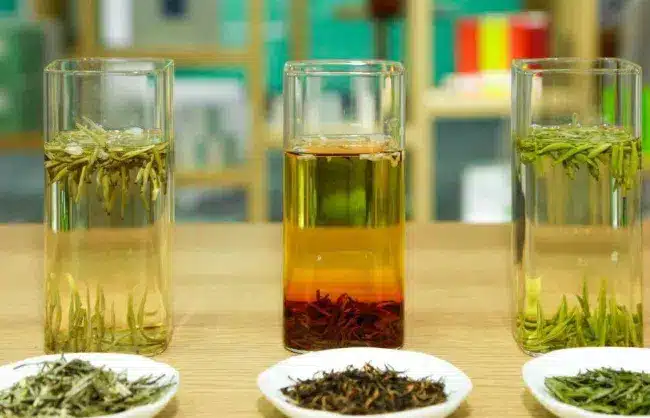
1. Green Tea
Fermenting Degree: 0% (non-fermented tea)
Tea Soup: Clear, light green
Famous Green Tea: Longjing (Dragon Well Tea), Biluochun, Huangshan Maofeng, Xinyang Maojian, Lu’an Guapian (Melon Seed Tea), Lushan Yunwu…
Green tea is the most popular type of Chinese tea, made of new shoots picked from the tea plants. The making of green tea only needs 3 steps – roasting, rolling and drying – in order to well retain the fresh color as well as rich nutrients of the leaves. This simple process makes Chinese green tea a healthy beverage which can help to prevent cancer, lose weight and reduce the harm of nicotine to smokers.
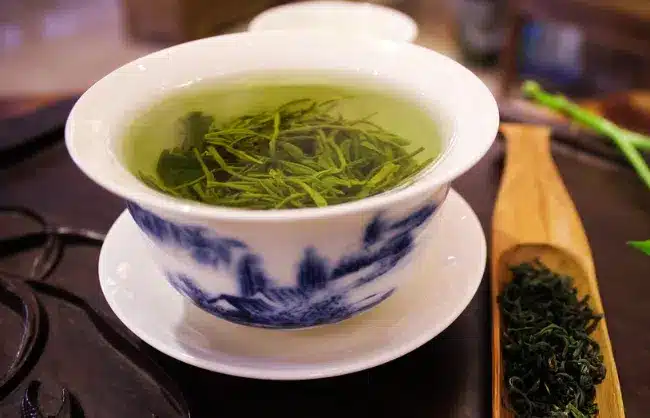
2. White Tea
Fermenting Degree: 0-10% (lightly fermented tea)
Tea Soup: Clear, yellowish green
Famous White Tea: Baihao Yinzhen (Silver Needle), Baimudan (White Peony Tea), Shou Mei, Gong Mei…
White tea is made from young tea shoots and buds. There is a thin layer of white down on the back of the leaves, hence the name. It is the least-processed type of Chinese tea that only goes through the drying process. The white tea is characterized by transparent and yellowish green soup, and offers a delicate flavor and sweet aftertaste with a smooth and silky texture.
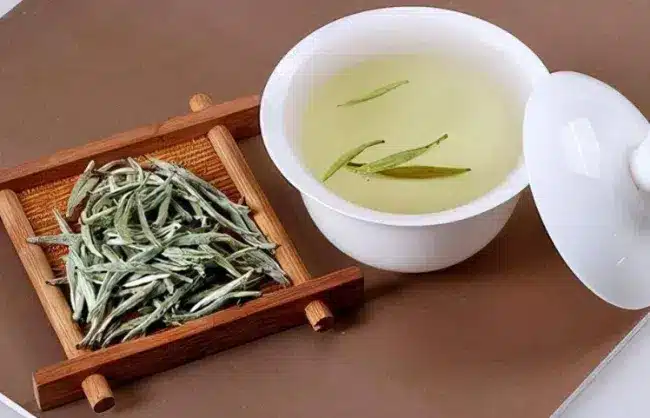
3. Yellow Tea
Fermenting Degree: 10-20% (lightly fermented tea)
Tea Soup: Bright apricot yellow
Famous Yellow Tea: Junshan Yinzhen, Mengding Huangya, Huoshan Huangya, Yuan’an Yellow Tea, Pingyang Huangtang, Guangdong Dayeqing…
As its name indicates, yellow tea is a lightly fermented Chinese tea, featuring distinctive apricot leaves and soup. The processing technique is quite similar with that of the green tea, but involves a unique step called “Men Huang”, which means heaping up the tea leaves to let them oxidated. It is the most crucial stage to get the iconic yellow color for the leaves.
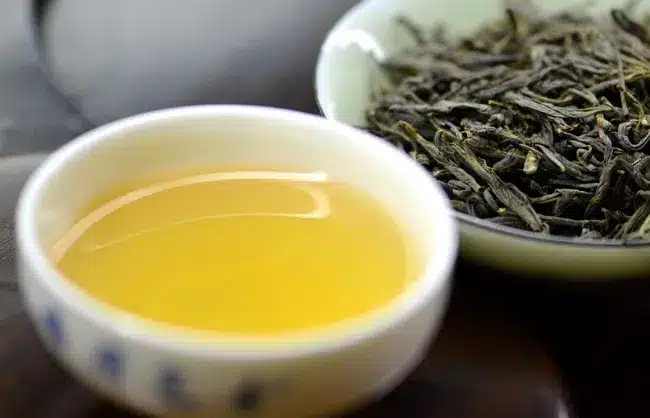
4. Oolong Tea
Fermenting Degree: 30-60% (semi-fermented tea)
Tea Soup: Honey yellow
Famous Oolong Tea: Anxi Tie Guan Yin, Fenghuang Dancong, Dongfang Meiren (Oriental Beauty Tea), Wuyi Yancha (Wuyi Rock Tea), Da Hong Pao (Big Red Robe) …
Chinese oolong tea is known for its great varieties and distinctive taste that combines both the fragrance of the green tea and the mellow texture of the black tea. As a semi-fermented tea, oolong tea can be brewed for 7-8 times, with each infusion bringing out different flavors and aromas.
Drinking oolong tea regularly is beneficial to people’s health as it contains lots of nutrients and biologically active ingredients that could help to resist oxidation, reduce blood lipids, regulate intestinal flora balance…
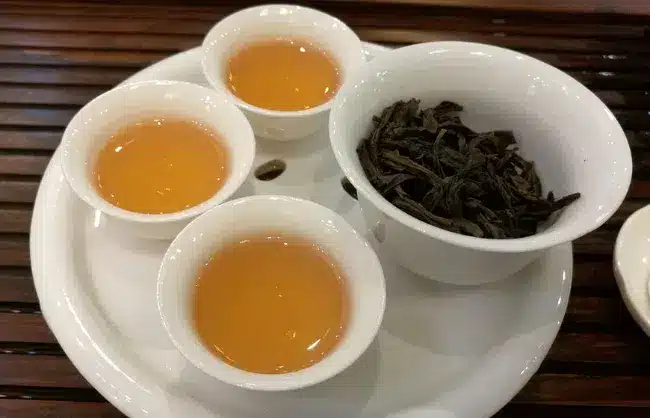
5. Black Tea
Fermenting Degree: 80-90% (fully fermented tea)
Tea Soup: Bright amber
Famous Black Tea: Zhengshan Xiaozhong, Keemun (Qimen) Black Tea, Yunnan Dianhong Tea, Zhenghe Gongfu Tea, Tanyang Gongfu Tea, Jiuqu Hongmei (Red Plum Black Tea) …
Black tea, also called Red Tea in Chinese, is another popular type of Chinese tea. It is made by fully oxidizing the tea leaves through a series of sophisticated processes to create the crimson color as well as the mellow, strong flavor which is accompanied with a little bit burnt smell.
Thousands of years ago, Chinese black tea arrived in Europe along the Silk Road and was much loved by lords and ladies of the western world. Today, this kind of tea is often enjoyed with milk and sugar, and makes for a perfect beverage for breakfast and high tea.
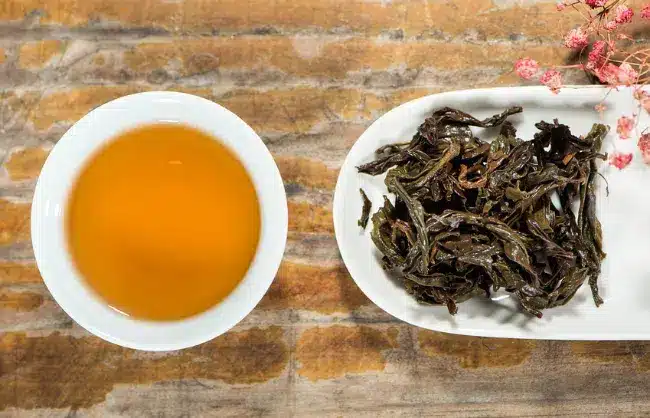
6. Dark Tea
Fermenting Degree: 90-100% (post-fermented tea)
Tea Soup: Brownish, burgundy red
Famous Black Tea: Hunan Anhua Dark Tea, Pu-erh Tea, Liubao Tea, Jingyang Fuzhuan Brick Tea…
This type of Chinese tea is named for its dark appearance due to a long time of pile-fermentation. It is mostly produced in southwestern China, such as Sichuan, Yunnan, Hubei and Hunan. Dark tea is often consumed with meals and is believed to aid digestion and help boost metabolic function. Therefore, some even take it as a weight-loss tea.
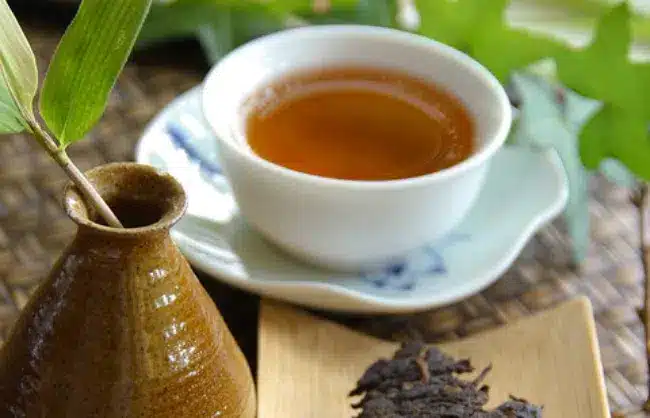
Recommended China Silk Road Tours:
- 7 Days Silk Road Small Group Tour of Xi’an –Zhangye – Dunhuang
- 14 Days Silk Road and Northern Xinjiang Tour
Aside from the mentioned major tea types, Chinese herbal tea, such as jujube tea, jasmine tea, and rose tea, is also widely loved by people, especially women because of its fragrant, floral flavor.
There is another kind of beverage in China, called “bubble tea”, which is made by mixing oolong tea or dark tea with milk, juice, and cassava balls according to different tastes. It is an iconic delicacy of Taiwan, China, and has now become popular throughout the whole country, especially among young people in China.
How to Make Chinese Tea – Chinese Tea Ceremony
Tea ceremony (“Cha Dao” in Chinese) is an important part of Chinese tea culture. Far more than just a way of drinking tea, the tea ceremony is a ritualized practice often performed for guests as a way to demonstrate hospitality and respect.
Generally, a typical tea ceremony involves 7 major steps:
1. Wash Hands and Prepare Tea Set
Both the tea master and guests need to wash their hands. Then the host will prepare a full tea set, consisting of teacups, tea pots, tea bowls, tea spoons, saucers, tea-trays… Chinese tea set made of porcelain and purple clay is commonly used for the tea ceremony.
2. Preheat Tea Pot and Teacups
All the vessels should be rinsed with hot water in order to get thoroughly cleaned and warmed up. It is a vital step as preheated pot and cups can better keep the temperature of the tea soup, and thus offer a richer and mellower taste.
3. Put Tea Leaves into the Pot
An appropriate amount of tea leaves is spooned into the pot according to the size of the tea set. Otherwise, the taste of the tea soup will be either too light or too strong.
4. Wash Tea Leaves
Pour hot water into the teapot, let it stand for a few seconds and then drain the water out. This step is about removing dust and tiny particles on the surface of the tea leaves. It can also help to fully bring out the aroma of the tea during the following process.
5. Brew the Tea
The boiling water is poured in the teapot again, cover the teapot and then pour boiled water over it to make the same temperature both inside and out. This has the benefit of allowing the water to stay warm for a longer time, which offers a stable environment for the tea leaves to open up and to release more flavor and aroma.
6. Serving the Brewed Tea
Pour the brewed tea into “Gong Dao Bei (a tea serving pitcher)” first, and then pour the tea soup into individual cups from Gong Dao Bei to make sure that every guest gets the same brew. Then the host will serve tea to guests with both hands.
7. Enjoy the Tea
Sniff the fragrant smell of the tea soup, and then take a sip to enjoy the refreshing aroma and mellow aftertaste.
How to Drink Chinese Tea Properly
It is widely known that drinking tea regularly benefits people’s health. However, it can still have negative effects on the body if one has tea at an inappropriate time or in the wrong way. Here are some tips you should be aware of when drinking Chinese tea:
- Make tea with a glass or a teacup made of porcelain or purple clay. Do not use metal cups or thermos bottles;
- Do not drink tea soup that has stood too long because the organic compounds in the tea will be spoiled, not good for health;
- Be sure not to drink tea on an empty stomach, or it will affect both your appetite and food digestion;
- Do not drink too much over-strong tea, as it can irritate the stomach;
- As Chinese tea contains caffeine, people suffering from neurasthenia or insomnia are not advised to have tea;
- It is not suitable for children, pregnant women, nursing mothers, or women in physiological periods to drink tea, except herbal tea.
Top Places to Experience Chinese Tea Culture
If you want an in-depth exploration of Chinese tea culture, do not miss the following destinations during your China tours. All of these are the main production areas of certain types of Chinese tea, enabling you to experience colorful tea culture and enjoy some of the best Chinese tea.
- Chengdu– The characteristic teahouse culture has become an important part of the slow lifestyle in Chengdu. Teahouses can be found everywhere in Chengdu and are always crowded with locals and visitors, chatting, watching the Sichuan Opera, and playing mahjong while savoring the tea.
- Hangzhou– Hangzhou is famous for its Longjing Tea. There are tea plantations around the iconic West Lake. Visitors can not only enjoy the idyllic scenery but also take part in hands-on activities such as tea leaf picking and tea making.
- Xishuangbanna– Located in the south of Yunnan Province, Xishuangbanna is well-known for its long history of cultivating Pu-erh tea plants. It was also the starting point of the Chinese Ancient Tea-Horse Road, an old trading route promoting the tea exchange with the Central Plain and countries in Western Asia and Europe.
- Suzhou– Suzhou has a prolonged history of drinking tea and there are many quaint teahouses, where visitors can have a leisurely time sipping the famous Biluochun Tea while enjoying the traditional local opera – Ping Tan.
- Fujian– As the main producer of Wuyi Brick Tea, Da Hong Pao, and Anxi Tie Guan Yin, Fujian is the best place in China to experience the oolong tea culture.
Experience Chinese Tea Culture with Us
If you are traveling to China and want to include a tea culture experience in your trip, the following are some popular China tea tour packages for your inspiration:







